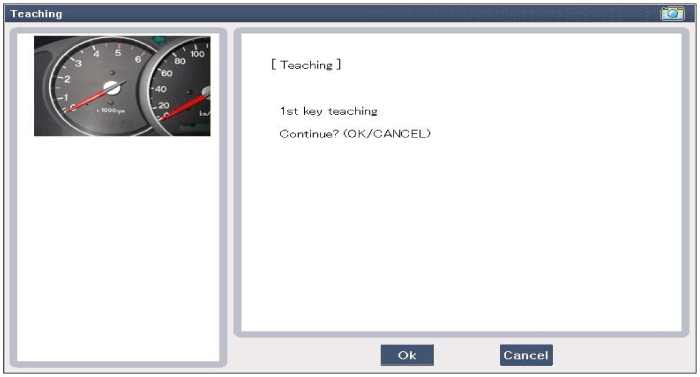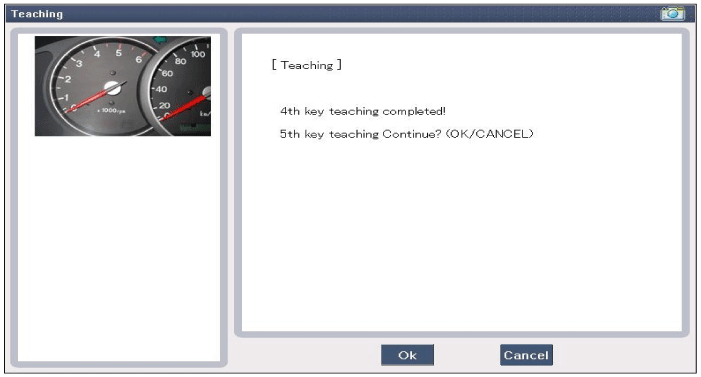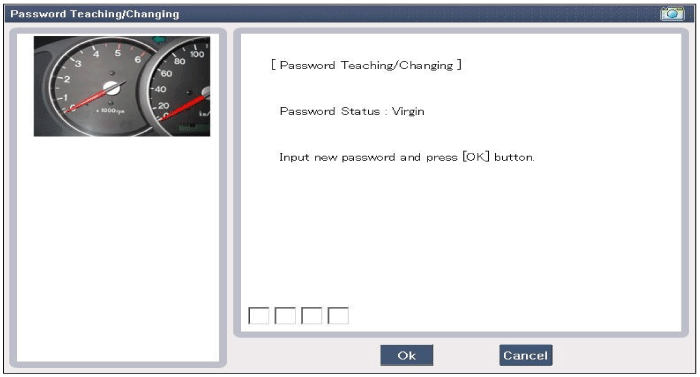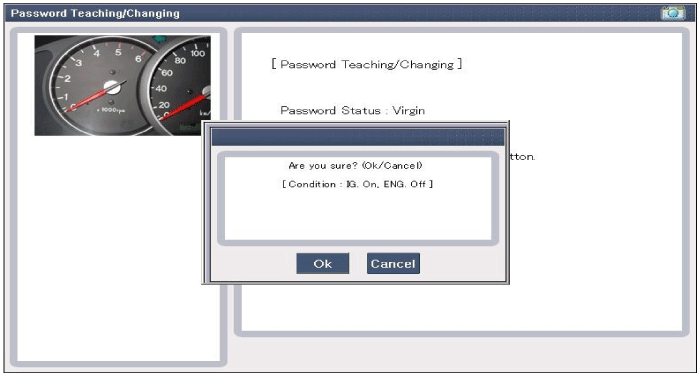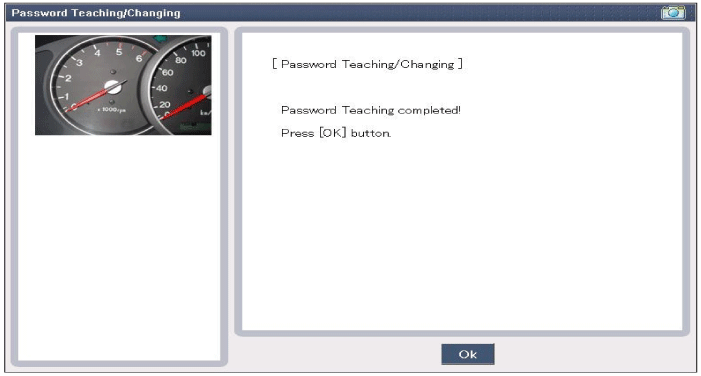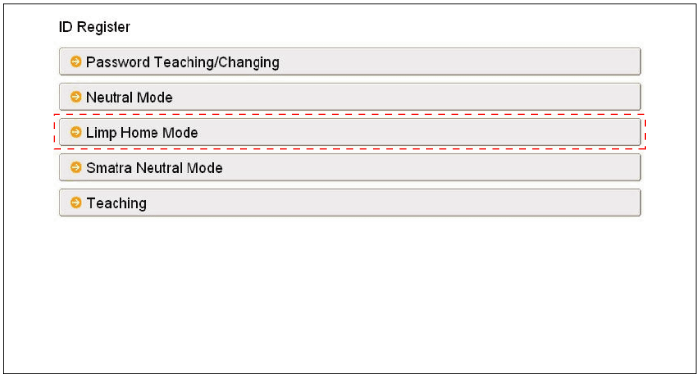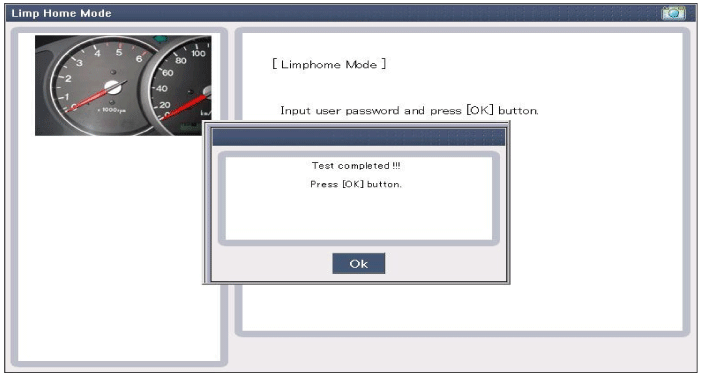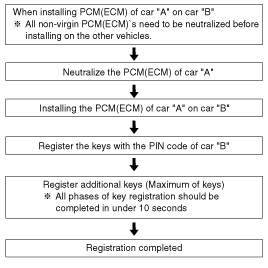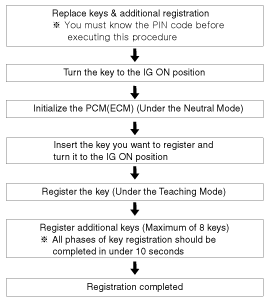 Hyundai Santa Fe: Repair procedures
Hyundai Santa Fe: Repair procedures
Teaching Procedures
| 1. |
Key Teaching Procedure
Key teaching must be done after replacing a defective
PCM(ECM) or when providing additional keys to the vehicle owner.
The procedure starts with a PCM(ECM) request for
vehicle specific data (PIN code: 6digits) from the tester. The "virgin"
PCM(ECM) stores the vehicle specific data and the key teaching can be
started. The "learnt" PCM(ECM) compares the vehicle specific data from
the tester with the stored data. If the data are correct, the teaching
can proceed.
If incorrect vehicle specific data have been sent
to the PCM(ECM) three times, the PCM(ECM) will reject the request of
key teaching for one hour. This time cannot be reduced by disconnecting
the battery or any other manipulation. After reconnecting the battery,
the timer starts again for one hour.
The key teaching is done by ignition on with the
key and additional tester commands. The PCM(ECM) stores the relevant
data in the EEPROM and in the transponder. Then the PCM(ECM) runs the
authentication required for confirmation of the teaching process. The
successful programming is then confirmed by a message to the tester.
If the key is already known to the PCM(ECM) from
a previous teaching, the authentication will be accepted and the EEPROM
data are updated. There is no changed transponder content (this is impossible
for a learnt transponder).
The attempt to repeatedly teach a key, which has
been taught already during the same teaching cycle, is recognized by
the PCM(ECM). This rejects the key and a message is sent to the tester.
The PCM(ECM) rejects invalid keys, which are presented
for teaching. A message is sent to the tester. The key can be invalid
due to faults in the transponder or other reasons, which result from
unsuccessful programming of data. If the PCM(ECM) detects different
authenticators of a transponder and an PCM(ECM), the key is considered
to be invalid.
The maximum number of taught keys is 4.
If an error occurs during the Immobilizer Service
Menu, the PCM(ECM) status remains unchanged and a specific fault code
is stored.
If the PCM(ECM) status and the key status do not
match for teaching of keys, the tester procedure will be stopped and
a specific fault code will be stored at PCM(ECM).
|
| 2. |
User Password Teaching Procedure
The user password for limp home is taught at the
service station. The owner of the vehicle can select a number with four
digits.
The user password teaching is only accepted by a
"learnt" PCM(ECM). Before first teaching of user password to an PCM(ECM),
the status of the password is "virgin" No limp home function is possible.
The teaching is started by ignition on, with a valid
key(learnt key) and sending the user password by tester. After successful
teaching, the status of the user password changes from "virgin" to "learnt"
The learnt user password can also be changed. This
can be done if the user password status is "learnt" and the tester sends
authorization of access, either the old user password or the vehicle
specific data. After correct authorization, the PCM(ECM) requests the
new user password. The status remains "learnt" and the new user password
will be valid for the next limp home mode.
If wrong user passwords or wrong vehicle specific
data have been sent to the PCM(ECM) three times continuously or intermittently,
the PCM(ECM) will reject the request to change the password for one
hour. This time cannot be reduced by disconnecting the battery or any
other actions. After reconnecting the battery, the timer starts again
for one hour.
|
Limp Home Function
| 1. |
Limp Home By Tester
If the PCM(ECM) detects the fault of the SMARTRA
or transponder, the PCM(ECM) will allow limp home function of the immobilizer.
Limp home is only possible if the user password (4 digits) has been
given to the PCM(ECM) before. This password can be selected by the vehicle
owner and is programmed at the service station.
The user password can be sent to the PCM(ECM) via
the special tester menu.
Only if the PCM(ECM) is in status "learnt" and the
user password status is "learnt" and the user password is correct, the
PCM(ECM) will be unlocked for a period of time (30 sec.). The engine
can only be started during this time. After the time has elapsed, engine
start is not possible.
If the wrong user password is sent, the PCM(ECM)
will reject the request of limp home for one hour. Disconnecting the
battery or any other action cannot reduce this time. After connecting
the battery to the PCM(ECM), the timer starts again for one hour.
|
| 2. |
Limp Home By Ignition Key
The limp home can be activated also by the ignition
key. The user password can be input to the PCM(ECM) by a special sequence
of ignition on/off.
Only if the PCM(ECM) is in status "learnt" and the
user password status is "learnt" and the user password is correct, the
PCM(ECM) will be unlocked for a period of time (30 sec.).
The engine can be started during this time. After
the time has elapsed, engine start is not possible. After a new password
has been input, the timer (30 sec.) will start again.
After ignition off, the PCM(ECM) is locked if the
timer has elapsed 8 seconds. For the next start, the input of the user
password is requested again.
|

Replacement
|
Problem |
Part set |
GDS required? |
|
All keys have been lost |
Blank key (4) |
YES |
|
Antenna coil unit does not work |
Antenna coil unit |
NO |
|
ECM does not work |
PCM(ECM) |
YES |
|
Ignition switch does not work |
Ignition switch with Antenna coil unit |
YES |
|
Unidentified vehicle specific data occurs |
Key, PCM(ECM) |
YES |
|
SMARTRA unit does not work |
SMARTRA unit |
YES |
| 1. |
Things to remember before a replacement (PCM(ECM))
|
| 2. |
Things to remember before a replacement (Keys & Additional
registration)
|
|









|







 Description and Operation
Description and Operation
Description The immobilizer system will disable the vehicle unless the proper ignition key is used, in addition to the currently available anti-theft systems such as car alarms, the immobilizer system ...
 Immobilizer Control Unit. Repair
procedures
Immobilizer Control Unit. Repair
procedures
Removal 1. Disconnect the negative (-) battery terminal. 2. Remove the driver crash pad lower panel. 3. Remove the knee airbag module. 4. Disconnect the connector of the immobilizer unit and then remove ...
See also:
Electric power steering (EPS)
The power steering uses a motor to assist you in steering the vehicle. If the engine is off or if the power steering system becomes inoperative, the vehicle may still be steered, but it will require increased ...
Side impact air bag
❈ The actual air bags in the vehicle may differ from the illustration. Your vehicle is equipped with a side impact air bag in each front seat. The purpose of the air bag is to provide the vehicle's ...
Purge Control Solenoid Valve (PCSV). Specifications
Specification Item Specification Coil Resistance (Ω) 19.0 ~ 22.0 [20°C(68°F)] ...




